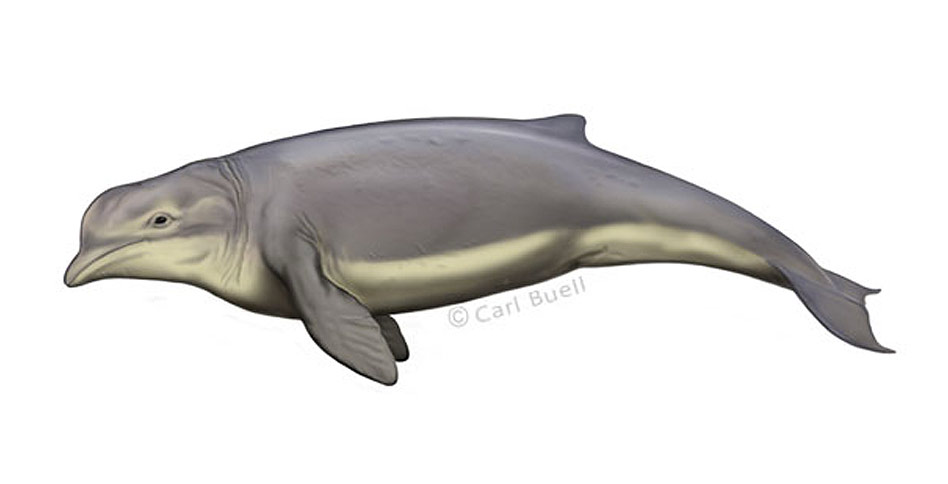
Simocetus rayi
Age: 30-34 Million years old, Oligocene Epoch
Range: Simocetus is only known from Oregon and inhabited the Eastern North Pacific Ocean.
Size: Unknown. The skull of Simocetus is approximately the same size as those of bottlenose dolphins (Tursiops truncatus). If the two species had similar body proportions, then Simocetus had a body length of 2-3 meters (6-9 feet).
Anatomy: In life, the head of Simocetus would not have resembled any modern dolphin. Simocetus likely possessed a melon, although given the short length of the snout and the position of the blowhole, the melon was probably small. The melon is a fat-filled sac that in modern toothed whales is used to focus and direct clicks, whistles, and other vocalizations. The snout was pointed slightly downward instead of being perfectly horizontal. The blowhole of Simocetus was also positioned very far forward as compared to those of modern dolphins and was placed in front of a high ridge of bone. Unlike all other modern and fossil toothed whales (odontocetes), Simocetus has the same number of teeth in the maxilla as archaeocete cetaceans and land mammals. Modern toothed whales generally are characterized by ‘polydonty,’ having more than 44 teeth in the mouth (note: some modern cetaceans, like Risso’s dolphin, have very few teeth, but this reflects a later loss of teeth after the evolution of polydonty). Additionally, there are no tooth sockets for the front three teeth (incisors), and it is possible that these were lost in Simocetus or were very small and embedded in the gums. Many of the teeth in the upper jaw point sideways instead of downwards.
Locomotion: Although some vertebrae are known of the original Simocetus fossil specimen, these have not been published. Thus little is known regarding locomotion of this interesting animal. However, earlier archaeocetes like Dorudon are known to be fully marine, likely had tail flukes, and had a forelimb with inflexible joints so as to form a hydrofoil-like flipper. It is probable that, like other crown cetaceans, Simocetus possessed all of these features.
Sensory Abilities: Like all other toothed whales, many archaeocetes, and early mysticetes, Simocetus exhibits a large hole (mandibular foramen) and canal with thin bony walls in the lower jaw. In life, the hole and canal housed a large pad of fat (the mandibular fat pad), which in modern toothed whales channels sound into the middle and inner ear. This feature indicates that Simocetus was well equipped to hear underwater sound. Modern toothed whales have a series of air-filled sinuses (called the pterygoid sinuses) in the skull in front of and below the braincase that are hypothesized to isolate the inner ear from the whale’s own vocalizations. These sinuses are well-developed in Simocetus and may be evidence that Simocetus was able to echolocate. Additionally, the presence of a concave surface on the snout, presumably for a melon, suggests that Simocetus may have been able to produce high-frequency sounds for echolocation. Curiously, Simocetus exhibits a pair of pits on the very front end of the palate, which have been tentatively interpreted as pits for the Jacobsen’s organ. The Jacobson’s organ serves as an additional sense organ with the ability to detect (i.e. ‘smell’) certain chemicals; however, in mammals for which this organ has been studied in detailed, it sits within the nasal cavity and communicates with the oral cavity via a short canal. The pits in Simocetus are restricted to the oral cavity, suggesting that some soft tissue structure other than the Jacobson’s organ occupied these depressions.
Diet: The strange teeth, snout, and jaws of Simocetus are evidence that it fed in a manner quite unlike most modern (and other fossil) toothed whales. Instead of being horizontal, the snout is deflected slightly downwards, a feature unique among toothed whales*. However, this deflection of the snout is also known in sea cows, where the degree of downward deflection is related to the grazing of algae and seagrass on the sea bottom. The teeth and jaws of Simocetus do not suggest an herbivorous diet and are not strong enough to have been effective at feeding on hard-shelled mollusks, like a sea otter. Instead, Simocetus may have fed upon soft-bodied invertebrates like crustaceans from the seafloor. However, the teeth of Simocetus do not appear to have been worn by sandy sediment. Tooth wear studies could help resolve the strange feeding behavior of Simocetus, particularly if more skulls with teeth were found and studied.
Author: Robert Boessenecker
References Consulted:
Fordyce, R.E. 2002. Simocetus rayi (Odontoceti: Simocetidae, new family): a bizarre new archaic Oligocene dolphin from the Eastern North Pacific. Pp. 185-222 In Emry, R.J. (ed.), Cenozoic Mammals of Land and Sea: Tributes to the career of Clayton E. Ray. Smithsonian Contributions to Paleobiology 93.
*An archaeocete (Protocetidae) cetacean, Makaracetus, also has a deflected snout, and has been hypothesized to feed in a similar manner.